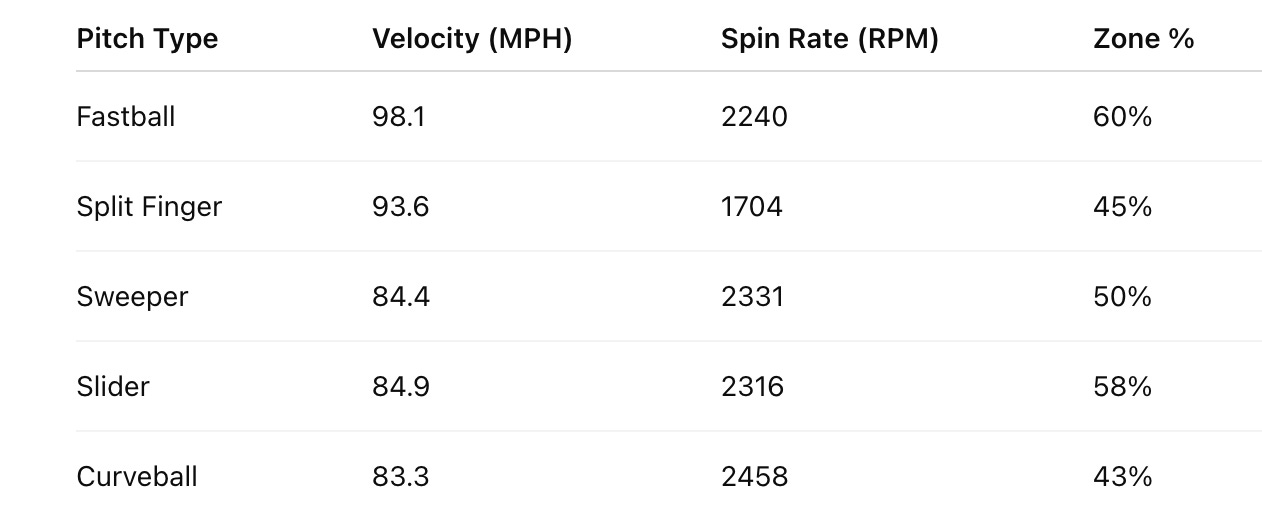What Spin Rate Couldn’t Explain About Pitching Command
Edition #262
Whipstache asked two questions about spin rate and command.
So, I broke down Paul Skenes’ entire pitch mix, velocity, spin, zone%, and the numbers didn’t add up like you’d expect.
That led to the debut of a brand-new stat: the Pitching Command Score, and a closer look at how pitchers actually age.
In this day and age, especially when we’re talking about the MLB, velocity means everything. Or at least, that’s what everyone thinks.
But the other day, Whipstache brought the case of Charlie Morton to my attention.
I recently wrote a piece about Charlie Morton. I was expecting to find that his complete disintegration was from a precipitous decline in elite spin rate. I was surprised to find that his spin rate is basically what it has been the last couple of seasons, and instead, his control fell off a cliff.
Then he asked two questions: Is it harder to consistently place a pitch that has a higher spin rate? Does command have a similar decline arc to velocity for pitchers toward the end of their careers?
Let’s start with his first question. Is it harder to consistently place a pitch that has a higher spin rate?
Well, yes, to a degree, but honestly, it’s pretty complicated, and it depends on the type of pitch.
Obviously, the higher the spin rate, the more movement we see on the pitch. This makes precision (or the exact location of the pitch) extremely difficult.
Remember this, though, pitches with higher spin rates doesn’t exclude the fastball.
Let’s take a look at Paul Skenes. On average, he throws his fastball 98.1 MPH. He will typically have 14.4 revolutions (2240 RPM) from his hand to the plate. He throws it in the strike zone 60% of the time.
On average, he throws his split finger 93.6 MPH. He will typically have 11.4 revolutions (1704 RPM) from his hand to the plate. He throws it in the strike zone 45% of the time.
On average, he throws his sweeper 84.4 MPH. He will typically have 17.4 revolutions (2331 RPM) from his hand to the plate. He throws it in the strike zone 50% of the time.
On average, he throws his slider 84.9 MPH. He will typically have 17.2 revolutions (2316 RPM) from his hand to the plate. He throws it in the strike zone 58% of the time.
On average, he throws his curveball 83.3 MPH. He will typically have 18.5 revolutions (2458 RPM) from his hand to the plate. He throws it in the strike zone 43% of the time.
Making Sense of the Data
The stuff we see here from Paul Skenes is kinda weird. But it’s just like what I said at the start. It really depends on the pitch. His fastball is measured at 2240 RPM, and he’s putting it in 60% of the time. If we take a look at his split finger, it’s measured at 1704, and he’s putting it in 45% of the time. His sweeper is measured at 2331 RPM, and he’s putting it in 50% of the time. He throws the slider at 2316 RPM, and he’s putting it in 58% of the time. Finally, his curveball is measured at 2458 RPM, and he’s putting it in 43% of the time.
So, we can already tell here that even with the fastball having a higher spin rate than the split finger, he’s still putting it in the fastball, the pitch with the higher spin rate1, more than the split finger, the pitch with the lowest spin rate. Then again, the curveball has a very high spin rate, but he’s putting it in less than the split finger which is the pitch with the least spin rate.
Does Command Decline Like Velocity?
Now, moving on to the other question. Does command have a similar decline arc to velocity for pitchers toward the end of their careers? The answer is no.
There isn’t really a certain statistic to measure command, so I decided to come up with my own formula, and it’s pretty sensible. I’m going to call it the Pitching Command Score2.
Now, a value from 140-150 is considered league average. Values from 150-170 are considered above average. Values 170+ are elite.
Verlander vs. Weaver: The Arc of Aging
What better way to answer this question than to talk about Justin Verlander?
In 2017, when Justin Verlander and the Astros won the World Series (the Astros used trash cans to steal signals in the World Series versus the Los Angeles Dodgers), Verlander recorded a score of 180.7.
So far, in 2025, Justin Verlander (now on the San Francisco Giants) has a pitching command score of 179.3. Elite.
On the other hand, when we take a look at velocity, one of the best examples has to be Jered Weaver, who had an average fastball in the mid-90s during the early 2010s before that number dropped down to the 80s as the decade moved along.
So, what do you value more in a pitcher, velocity or command? Drop your take below.
It’s higher because that’s how Paul Skenes throws it. Not everyone’s fastball will be measured at 2240 RPM.
BB%, Zone%, O-Swing%, Meatball%, First Pitch Strikes%, Edge%, CS% were the statistics used in the measurement.




